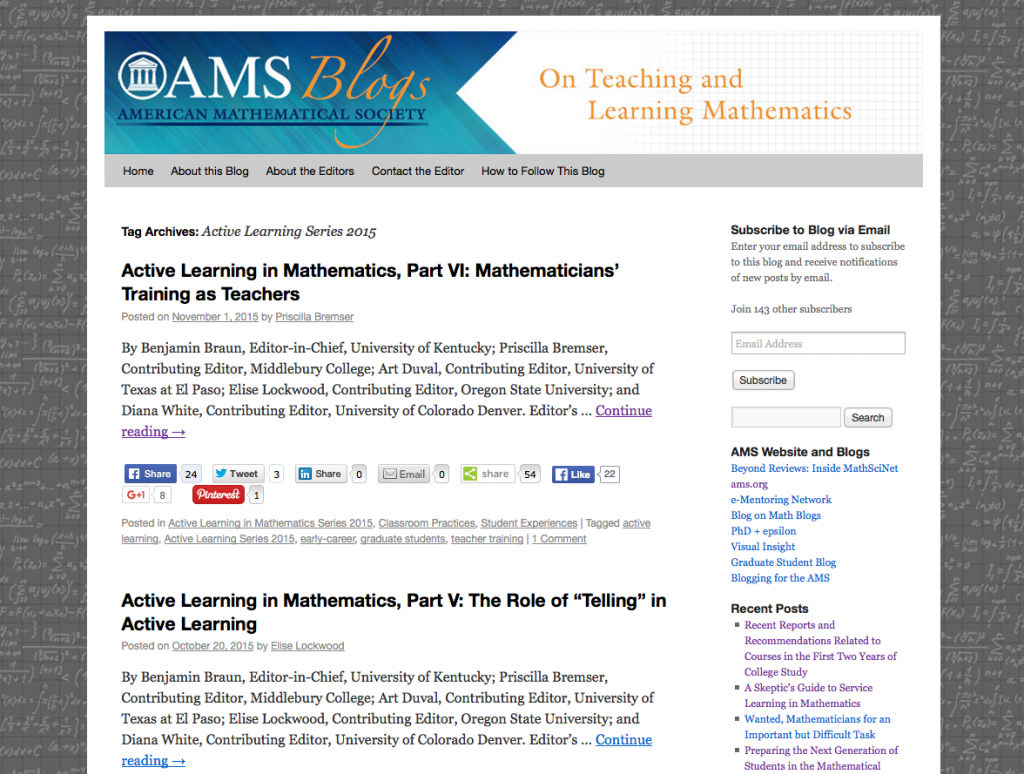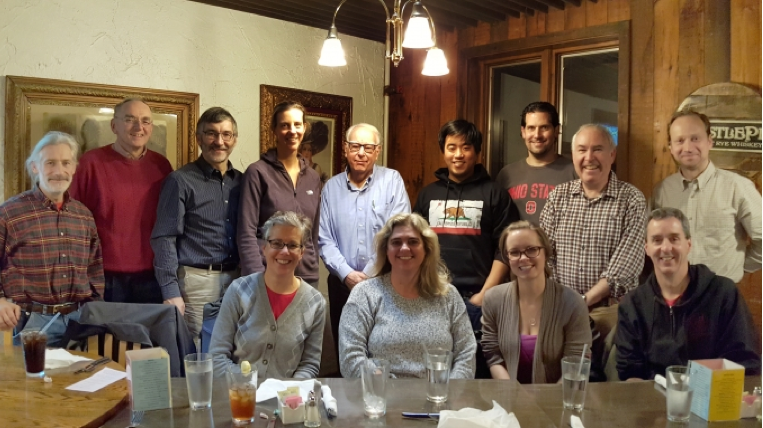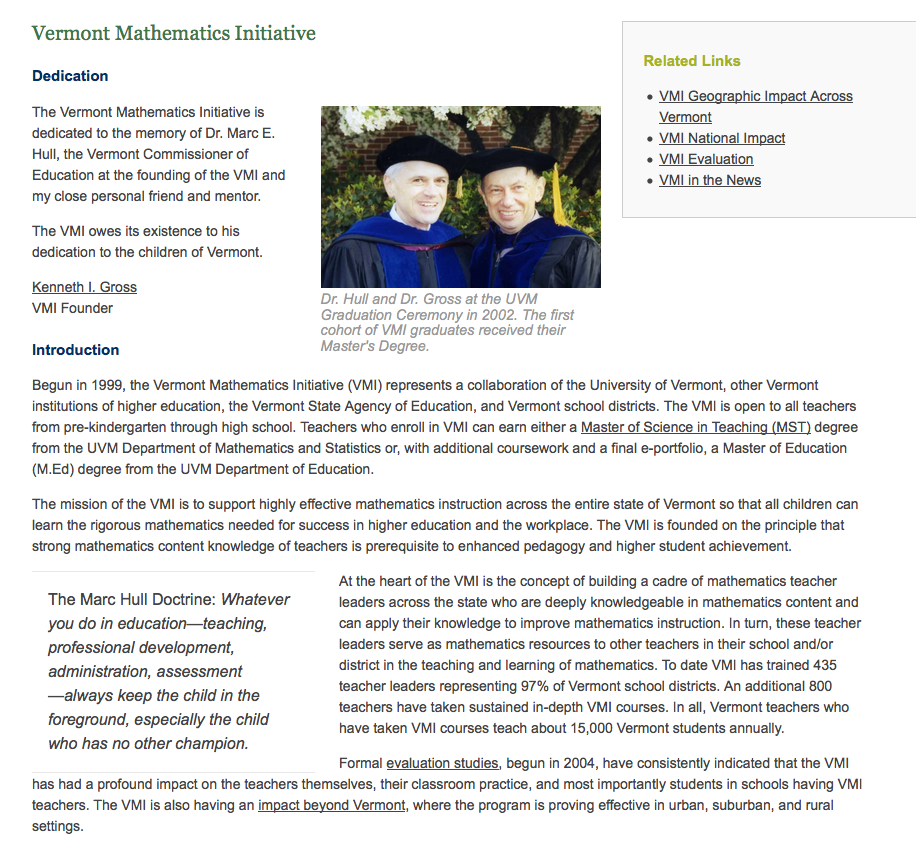 Recent interest in active learning techniques and the positive impact that they can have on student learning put Professor of Mathematics Priscilla Bremser on our radar. You can read a series of blog posts on active learning in mathematics that Professor Bremser co-authored on the American Mathematical Society blog here. (There is excellent pedagogy content here that can be applied in multiple disciplines. Two examples are her posts about syllabus development and tips for integrating service learning into your curriculum.)
Recent interest in active learning techniques and the positive impact that they can have on student learning put Professor of Mathematics Priscilla Bremser on our radar. You can read a series of blog posts on active learning in mathematics that Professor Bremser co-authored on the American Mathematical Society blog here. (There is excellent pedagogy content here that can be applied in multiple disciplines. Two examples are her posts about syllabus development and tips for integrating service learning into your curriculum.)
After reading the blog I was thrilled to realize that one of the authors was a faculty member at Middlebury! After reaching out via email, Professor Bremser kindly agreed to sit down with me over j-term and talk about her teaching practice.
At the beginning…
To begin, I asked how she became interested in pursuing active learning practices in her classroom. Priscilla related that it started 20+ years ago when she attended a conference at Bowdoin about mathematics educational reform. William Barker, a professor at Bowdoin, shared his method for replacing lecture with small-group work and including peer review in the homework cycle.
Priscilla decided to completely overhaul her Abstract Algebra class the next semester. She shares that the collegiality in the mathematics department has been a key strength in giving her the freedom to teach as she sees fit. The changes in her Calculus instruction have come more slowly. Her first step was retaining the lecture on the majority of meeting days each week, but transforming one day into a lab where students actively worked on problems in groups.
A focus on teaching
Her work has been influenced by collaborative partnerships with k-12 mathematics teachers in Vermont. Priscilla has been actively involved in the Vermont Math Initiative, a professional development program for k – 8 teachers. This position has allowed her to experience active learning with a different audience and an emphasis on community. She was struck by the lack of judgement surrounding mathematical misconceptions and the supportive and thoughtful nature of the group. Priscilla used this experience to consider what was happening in her own classroom. What she consistently saw was that students enter college with strong procedural mathematical knowledge and a misconception that this is all math is. In contrast, she hoped to use active learning to strengthen students’ conceptual math understanding by allowing them to employ their knowledge in various problem scenarios.
Priscilla then began to employ these techniques in Linear Algebra. The course serves as an introduction to proof writing. She assigned homework to challenge the students and spur conversations and then during class sessions students were asked to make an observation about calculations. That observation might begin with the prompts:
- What did you notice?
- Explain…
- Given that…
The students would meet in groups of 3 or 4 to figure out issues based on their observations. Priscilla shared that it took the students two weeks to understand that homework was not being used as an assessment tool, but as a learning tool. The grader for the class had been asked to look for a good faith effort, and that the students’ complete work was shown. The object was not to show perfection, and she reminded the students they did not need to let her know that they were not sure if their answer was right.
As the class continued Priscilla noticed that the students began to listen to each other differently and (as intended) the student discussion and learning became the focus of the class rather than the lecture.
Making space for mistakes…and brilliance.
Professor Bremser wanted her students to both learn the conventions of proof writing and begin to think like mathematicians. She acknowledged that this methodology required her to sacrifice some coverage of materials, but that students often exhibited a greater depth of knowledge than they had previously been able to achieve in the concepts that were covered. Feedback from students was mostly positive, although there is always some discomfort with speaking in front of the class. Part of her role was creating a classroom environment where it is understood that making mistakes is a part of the process.
To create this environment Bremser took the first day of class and devoted it to small group discussions in response to the following questions:
- What is the goal of a liberal arts education?
- What do you expect to remember 10 years after you leave Middlebury?
- How do you learn something new?
Students acknowledged in this format that making mistakes was a part of learning new things. Priscilla used this information to ask “How do you create a space for making mistakes?” The student response was sobering. “In this culture? You don’t.” Bremser used this as an opportunity to discuss differences with the students and point out that her goal is not to embarrass anyone, but rather to figure out when there is a problem with your problem solving method, when something isn’t making sense, and when to ask for help.
Bremser acknowledges that classroom dynamics play a role in how successful active learning methods are in class. Different personalities and lapses in attendance can have an impact on the cohesiveness of the group. She sometimes encounters student resistance and a desire for the expert to explain the one right way to do a problem. In response, she notes that the flashes of brilliance that she sees in her students were not visible to her before. Having a more student-driven focus has allowed her students to come up with new solutions to problems that are of a higher level of conceptual understanding than she ever expected.
The power of a network
Priscilla shares that the collegiality within her department has been instrumental in her success in her exploration of active learning techniques. Steve Abbott had done similar work on active learning when Priscilla first started practicing this methodology and Michael Olinick employs the Moore method within a 400 level course for math majors that allows them to critique presentations like mathematicians. Being able to share and discuss their processes, methods and results within the department has provided a support network and feedback loop that has been extremely beneficial.
Through talking with Priscilla her exuberance and excitement for learning and her students’ achievements is ever present. As we wrap up our discussion she mentions the impact her discussions with Barbara Hofer on cognitive psychology have had on her understanding of student learning and teaching practices. Our discussion reminds me of the depth of experience and knowledge we are privileged to share at Middlebury, and the many opportunities that exist for collaboration with and learning from each other.
An interview with Professor Priscilla Bremser, Nathan Berman Professor of Mathematics as shared by Heather Stafford, Academic Technologist.



